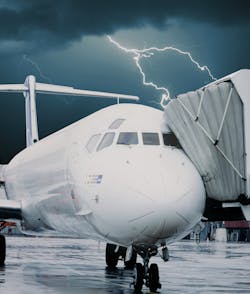How To Recover From IROPS
When regular operations turn into irregular operations (IROPS), airports and airlines must communicate, share responsibility and work together to create a plan that offers real solutions – not just for the unlucky passengers, but also the ground support crews.
A recent DOT/FAA Diversion Forum, for example, initiated an industry-wide effort among airports, airlines and air traffic control systems to share real-time information on ground conditions, available gates and ramp closures to better prepare and respond to severe weather events.
An Advanced Visual Docking Guidance System (A-VDGS) can link gates and integrate with other airport and airline systems to generate and share just such real-time information. Even during IROPS, the system can bring more aircraft to the gates. That means passengers can get on their way and pilots can head to their next destinations.
Also, an A-VDGS helps ramp operations stay on track by keeping things moving. Even when severe weather sends ground crews indoors, the equipment's automated docking system identifies available gates and lets pilots self-park their planes at those gates. Any aircraft type from any airline can be parked at compatible gates equipped with the system even in hazardous conditions.
For example, when lightning strikes within an established range a "RAMP CLOSED" warning message can be conveyed to ramp workers on the A-VDGS display. This message can either be automatically triggered via an interface to a lightning detection system or manually done at the gate operating system console that immediately sends the message to all displays. Airlines can develop procedures to ensure gate areas are clear of obstacles as personnel vacate the ramp.
When an aircraft arrives, the information is sent to the A-VDGS at the assigned gate and the "RAMP CLOSED" message is replaced with the standard docking guidance information. If the assigned gate is unavailable, the gate operating system provides real-time information on alternate gates. Only pre-programmed, compatible aircraft types are allowed into these gates.
When the ramp reopens, ground crews can get back to work quicker thanks to aircraft already parked at the gates. Taxiways are clear and ramp personnel can focus on pushing back aircraft waiting to depart.
HOW AN A-VDGS WORKS
The most commonly used A-VDGS employs three-dimensional laser scanning to identify an approaching aircraft and provide active azimuth and stop guidance to the pilots via a high-intensity LED display.
An A-VDGS can identify the position of a passenger boarding bridge to verify that the bridge is safely stowed prior to docking. The system also ensures the gate area is ready and prevents incompatible aircraft from parking at adjacent gates.
These systems are installed on nearly 5,000 gates around the world, including more than 500 at North American airports.
When delays can't be avoided, the equipment's gate operating system manages them by networking all gates and integrating with other airport and airline information systems to communicate real-time gate availability, accurate in/out times and ramp closure information that are all key to mitigating extended delays. For example, the system can start the clock for aircraft landing or leaving the gate. Time alerts sent to aircraft and airport operations can help monitor the length of delays.
An extensive network of A-VDGS users could share real-time conditions and available gate information between any number of airports and airlines as more airports add these systems, either airport-wide or on gates designated for use during IROPS. This network will greatly improve communication and help avoid diverting flights to airports that do not have the resources to accommodate them.
The ability to effectively manage available gates and bring more aircraft to the gates even during severe weather events – and, especially, during ramp closures – can significantly improve performance during IROPS and ensure a faster recovery for all involved.
REGULAR OPERATIONS, TOO
When airlines delay, cancel or divert flights, much of the challenge shifts to airports. Tarmac delays, ramp congestion and closed gates then put the burden on the ground support crews.
And that burden is likely to increase regardless of the reasons. The NextGen Air Transportation System, for example, is expected to reduce delays and provide greater flexibility to get around weather problems in the air.
Improved capacity in the air, however, will strike a delicate balance on the ground between surface and gate capacity. As a result, ground crews will have to perform their work consistently in all types of weather.
The most advanced gate operating system manages the entire arrival and departure process and provides a link between the movement and non-movement areas. As a result, the A-VDGS becomes the natural connection point to integrate all airport and airline systems as well as all equipment on the ramp.
Such a system collects and distributes real-time gate intelligence and accurate flight information to airport, airline and air traffic control systems. This means planes get to the gates quickly and ramp workers can perform their jobs safely and efficiently during IROPS and regular operating conditions.
Even in favorable operating conditions, the A-VDGS allows aircraft to dock before ramp personnel can even get in position As a result, more airplanes get to their gates on time, and the ground crews can focus on other duties. This saves the airlines costly fuel, improves safety for ramp workers and enhances passenger service.
About the Author: Tammi Phippen is the marketing communications manager for Safegate Airport Systems Inc., a subsidiary of the Safegate Group. She joined the company in 2010 and has worked in the aviation industry for more than 20 years.
